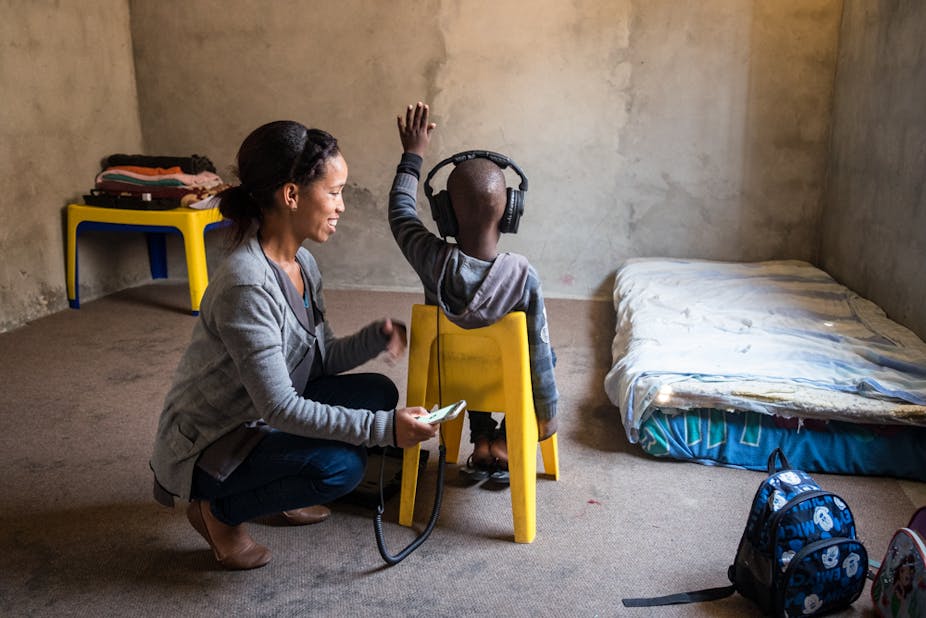Healthy hearing and vision in early childhood are the foundation for success at school. Hearing and vision difficulties are the most common developmental disabilities in children younger than 5 years, with more than 40 million affected globally. But more than 90% of children with hearing or vision loss live in low and middle-income countries where services to detect problems early are unavailable.
Called invisible disabilities hearing and vision loss cannot be identified without conducting a test. These tests, especially for hearing, have traditionally needed expensive equipment and trained health professionals such as audiologists.
Without systematic screening programmes these losses go undetected until children reach school age where they often have a devastating impact on development, academic outcomes, and socio-emotional well-being.
Over the last six years, I’ve been working with colleagues around the world to develop, implement and evaluate a number of hearing care models that can be delivered in communities using smartphone technologies and facilitated by minimally trained people. We’ve been targeting poor communities in particular.
Read more: We've developed a hearing app that can screen people in rural areas
The minimally trained people that we worked with included lay community members, community health workers, community care workers, and even teachers. They provided hearing-related services such as awareness programs, hearing screening, referral, follow-up and diagnostics in the children’s homes, preschools, schools and in clinics. In 2016, we introduced vision screening in a pilot project demonstrating the feasibility and value of combined screening.
Our most recent implementation study evaluates a service-delivery screening project in low-income communities by community members using mobile health (mHealth) technologies. The project has been run in the Western Cape in South Africa. This is the first report in the world of combined hearing and vision screening for young children.
Our findings show that a mobile health supported service-delivery system can dramatically increase access to hearing and vision services for preschool children in poor communities.
The research
Between September 2017 and December 2018 we introduced and implemented a screening programme in preschools in Khayelitsha and Mitchells Plain in Cape Town. Both are poor communities.
We appointed unemployed community members and trained them as lay health workers to provide both hearing and vision screening at preschool centres.
We gave the community health workers smartphones with pre-installed applications. The mobile health technology used was provided by the hearX Group, a digital health company that was started from our work at the University of Pretoria. The hearScreen app provided a quick and reliable hearing check using automated protocols and user-friendly designs. Vision was checked using the Peek Acuity app provided by the UK-based partner Peek Vision. Peek vision has been used previously for population-based testing in countries like Kenya.
Children who failed the initial hearing screening were screened for a second time a week later. The screening was done at their preschool. It included otoscopy, an examination that involves looking into the inner ear with an instrument called an otoscope. The project audiologist conducted this second screening. Children who failed this screening were referred to public health diagnostic audiology services.
Children who failed the initial vision screening and re-screening were referred to primary health care facilities for a diagnostic optometry evaluation.
All follow-up services and interventions were provided by public health services, for example, hearing aids, spectacles, or other medical intervention.
Our programme, the Ears and Eyes for Education project, is supported by a local NGO for children with hearing loss, the Carel du Toit centre, as an implementation partner. The project is also supported by the Swiss-based Hear the World foundation.
The results from the first 8023 children screened across 271 preschools show hearing and vision ability was accurately assessed at low cost.
Referral rates for follow-up services were comparable to school screening by health professionals. Average test time for hearing and vision in our programme was just over 2 minutes, cutting typical test times in half.
The community-based model meant that tests were done for $5.63. This included all costs related to testing and personnel.
More than a hundred children in this sample were diagnosed with a hearing or visual impairment for the very first time. They are now receiving treatment.
Scaling impact for hearing and vision care
The enormous disparity between the global need for hearing and vision services, and the inability of traditional models delivered by trained professionals to address this need, is a clear call for new ways of making care widely accessible.
This research showcases the potential of mobile health innovations to enable the transformation in the lives of children with hearing and vision problems. It is especially encouraging because children from disadvantaged communities, who already face many challenges, are being helped.

